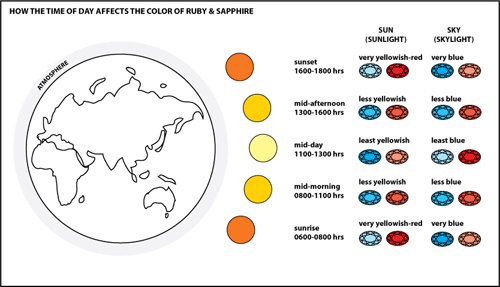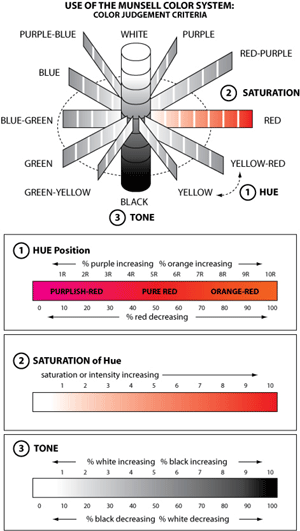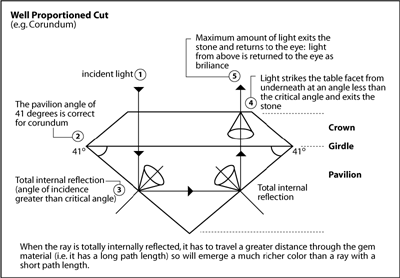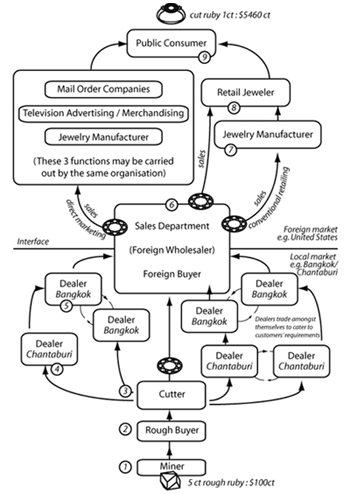GEMSTONE GRADING & APPRAISAL
by Li Ching Chia-Heng
Why is it difficult to assess the quality and value of gemstones? Yasukazu Suwa states this plainly:
"There are two reasons why it is difficult to assess the quality and value of gemstones. The first is because the quality of gemstones can only be verified by looking at them. Industrial products, such as automobiles and home appliances, have specific uses and fixed price ranges, so their value is apparent. It is easy to think of many other examples of products that differ in value that can be evaluated on the basis of the five sense. In contrast, the quality of gemstones is judged solely by the sense of sight.
Second, it is difficult to ascertain the value of gemstones because some are priced more than 100 times higher than others of the same name. Since gemstones are naturally occurring materials, each will differ in quality. Even veteran jewellers must use master stones for comparison when buying gemstones. The value of a gemstone is established by the rate of occurrence its quality level, and demand. Simply stated, while rubies priced at $10,000, $2,000 and $100 are all ruby, each is totally different."
Yasukazu Suwa divides quality into three zones: “accessory quality”, “jewellery quality” and “gem quality”. This roughly falls into the market segments of commercial, middle market and fine stones. The difference in these categories is based on Color, Clarity & Cut and results in huge price differences between stones. Put simply: You will not be able to price a stone accurately until you learn how to grade it well.
Gemstones are products of nature. Therefore there is no such thing a perfect gemstone. Small imperfections that have little negative effect on beauty or durability may give gems a special character and charm. Whether it is formal or informal, one needs training and constant practise to be able to grade gemstones well. How many times have you seen two gemstones that look fairly similar but are priced so differently? One could be dirt cheap and the other could cost the heavens. Is the jeweler/dealer pulling a fast one on you? Are your eyes playing tricks on you? Is it both? If taking several months to study gemology is not on your list of things to do, then here are some questions to ask yourself and help you make the right investment.
Light
What light source are you using to view the stones? Is it controlled and consistent artificial light source such as a grading lamp? Are you using natural light? If so, which direction is the light coming from? What time are you viewing the stone? What's the weather like? Is it sunny or downcast? In general, during a sunny day, it is best to view stones using northern skylight at between 10am to 2pm. It is also interesting to note that in dim lighting, blues and greens appear more vivid than reds and yellows (which look better in bright lights). Finally, what kind of stones are you looking at? Rubies look best at mid-day when skylight is least blue. Sapphires look best in the early morning and late afternoon when skylight is most blue.

 Color
Color
Cut is the most important "C" for diamonds. For colored gemstones, color is the most important "C". Slight differences and nuances in color can result in very different prices for ostensibly similar stones. This is further complicated by the fact that there are so many stones in different colors, every colored stone is different and everyone perceives color differently. This is one reason why there is no international standard for grading colored stones.
What can a lay person do? Imagine if you can colors that are intense, pure and balanced. That's what you want in fine gemstones. As a guide, rubies should be pure red with no hints of brown. Slight pinkish-red is also considered desirable. Sapphires should be pure blue with no grays. Violet-blue is also very desirable. For both stones, colors should be saturated and tone should be balance (neither too light nor too dark). When in shops or with dealers, train your eyes by looking as many stones as you can! It will take time, but you will eventually find this skill exceptionally useful.
Clarity
Unlike diamonds, colored stones do not depend heavily on clarity for their beauty. In fact, some inclusions are considered aesthetic properties and hallmarks. For example, the velvety texture of Kashmir sapphires is actually caused by minute inclusions that scatter light. We should also take into consideration that certain gemstones are naturally very included e.g. Emerald, Rubellite, and others are always very clean e.g. Topaz, Aquamarine. For the bulk of most colored stones, it is realistic to expect some inclusions. As a guide, a fine gemstone should not have any distracting blemishes or inclusions that will detract from its beauty.
Cut
There are many types of gemstones with differing optical and physical properties. Therefore, unlike diamond, there is no single ideal cut
proportion for colored gemstones. Also, unlike diamond, most colored stones are cut by hand and may not be totally perfect. In general, look for stones that "smile" at you from afar. There should not be overly distracting "windows" or areas of darkness (called "extinction"). Although how a stone is cut has much to do with its rough form, it should not be cut too thin or too fat. Due to the nature of their rough, many rubies are cut flat and shallow, and many sapphires are cut fat and deep. As a rule of thumb, stones should not have a depth percentage (depth divided by width) of less than 60% or more than 70%. Also check to see that the cut is proportionate and balanced with as few faults as possible, e.g. wavy girdle, off-center culet, chips, excessively thick or thin crown etc.

Carat
Fine stones in large sizes are rare. Therefore, it is logical that gemstone prices jump exponentially at each carat category. For example, if a ruby of 1ct is $1000/ct, one that is of the same or similar quality of 1.50ct to 1.99ct size can command $1,800/ct to $2,800/ct. At 2ct to 2.99ct, the entire stone may cost $8000 or more. At 3ct and above, perhaps $20,000 and up. Even larger stones? That's up to the seller!
On a micro level, (again, given that all C's are equal) a 1.01ct stone will always cost less per carat than a 1.05ct stone. The reason for this is simple. The small weight difference gives buyers a margin in which to re-polish and/or re-cut the stone without the stone dropping into a different carat category. For instance, if a gemstone of 1.01ct cost $300/ct, it may only command $150/ct if it became 0.99ct after re-polishing.
 Prices
Prices
There is no controlled supply line for colored stones. So while you can refer to the Rappaport for diamond prices and make a good gauge as to how much a diamond of a certain quality and size should cost, there is no such equivalent for colored stones.
Prices fluctuate and are different from region to region and country to country depending on demand and supply. The best way to get a feel of prices is to head out to the market and trade. Of course, this isn't realistic for many of us. So, for a rough gauge, refer to the US published "Guide" which gives wholesale prices of gemstones. Keep updated with publications such as Gems & Gemology, JCK, Colored Stones and so on. For the fine and extra-fine categories, it is also a good idea to check prices at Christie's and Sotheby's. (Remember, this is meant to be a "guide"! Do not bring these out to your jeweler or dealer!)
Look at the chain of distribution on the right. Who are you buying from? From step 1-5, add 10-30% at each step. From step 6 onwards, add another 50-600%. The further down the chain, the more you should expect to pay!